 This is part one of a four-part series by Karen Elowitt, who recently took a cruise on the Danube River. She spent eight days traveling between Budapest, Hungary, and Passau, Germany with Uniworld Cruises.
This is part one of a four-part series by Karen Elowitt, who recently took a cruise on the Danube River. She spent eight days traveling between Budapest, Hungary, and Passau, Germany with Uniworld Cruises.
In her dispatches she chronicles the cities she stopped in, the festive Christmas markets, and the pros and cons of river cruising.
River cruisers are the only visitors to Budapest who can truly say they stayed neither in Buda nor in Pest, the two parts of the city located on opposite sides of the river Danube.
Everyone else has to choose either the hilly Buda side, which is older and mostly residential, or the Pest (pronounced “pesht”) side, which is the flat, commercial section.
 No matter which side you choose, Budapest is a knockout as far as European capitals are concerned. Its grand boulevards take you past impossibly majestic buildings where history seeps from every crack and crevice. Liszt lived there. Emperor Franz Josef dined here. The 1956 uprising ended over there.
No matter which side you choose, Budapest is a knockout as far as European capitals are concerned. Its grand boulevards take you past impossibly majestic buildings where history seeps from every crack and crevice. Liszt lived there. Emperor Franz Josef dined here. The 1956 uprising ended over there.
Sweeping monuments commemorate lives lost, wars won, and noblemen who ruled. World-class museums chronicle the past, from pre-Roman times to the modern era. And a stunning castle overlooks the city from its perch high above the Danube, like a cherry on top of a luscious marzipan cake.
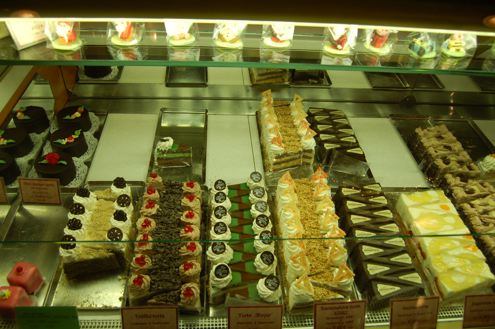 Marzipan is the pre-eminent confection in this candy-coated town, which is where my river cruise began. Docked mere inches from the center of the city, at the foot of a royal palace, my floating hotel was ideally situated to explore the capital of this country of 10.2 million—if only for a single action-packed day.
Marzipan is the pre-eminent confection in this candy-coated town, which is where my river cruise began. Docked mere inches from the center of the city, at the foot of a royal palace, my floating hotel was ideally situated to explore the capital of this country of 10.2 million—if only for a single action-packed day.
Uniworld gave us a taste of the city during a whistle-stop morning coach tour, which amounted to a very intense crash-course on the history of Budapest. Landmarks such as Castle Hill, where generations of Hapsburg emperors lived during the Austro-Hungarian Empire, to the Ministry of Justice building, the former headquarters of the Communist secret police, reminded us that domination and defeat at the hands of outside powers is a common thread of Hungarian history.
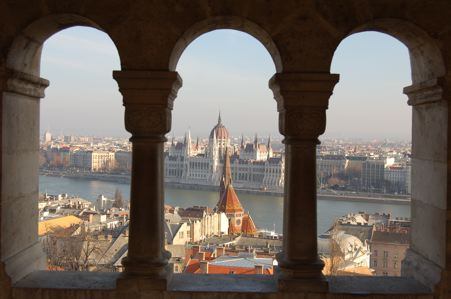 Some of the earliest invaders were the Romans, who conquered the native Celtic (yes Celtic) tribes that originally inhabited the area. Their legacy was the extensive system of public baths, of which there are 23 today, located on or near the sites of natural underground hot springs.
Some of the earliest invaders were the Romans, who conquered the native Celtic (yes Celtic) tribes that originally inhabited the area. Their legacy was the extensive system of public baths, of which there are 23 today, located on or near the sites of natural underground hot springs.
It was only later, after the Romans left, that the Magyar tribes moved in from central Asia and gave the country its name (“Magyar” is what Hungarians call their country) and the impenetrable language that bears a strong similarity to Finnish and Estonian.
Learn more with Hungarian Mineral Spas: Winter Bathing in Budapest.
The Turks also managed to conquer the city in the Middle Ages, and left their imprint on the language and on monuments such as the Matthias church, whose interior bears unusual Islamic-style motifs and colors. First a church, it was later converted to a mosque before being converted back to a church in 1686.
 Damaged, rebuilt and redesigned many times, the most recent restorer, Frigyes Schulek, opted to retain some of the design features both from the original Gothic structure and from the Ottoman era.
Damaged, rebuilt and redesigned many times, the most recent restorer, Frigyes Schulek, opted to retain some of the design features both from the original Gothic structure and from the Ottoman era.
The communist domination of the city after 1945 left a legacy that is still visible today. Many of the pre-war Baroque and neo-Gothic buildings still bear the scars of conflict in the form of bullet holes, while the tacky ’50s and ’60s-era concrete-and-glass structures remind visitors how little talent the Soviets had for architecture.
 Since my weeklong trip on the River Beatrice was officially a Christmas markets tour, I spent the afternoon strolling through the holiday market on Vörösmarty Square, perusing the handmade treasures. Despite the brisk 28-degree weather, I couldn’t tear myself away from the endless stalls selling intricately carved wooden ornaments, quirky crocheted hats, giant twists of strudel, roasted chestnuts, and Glühwein (hot mulled wine).
Since my weeklong trip on the River Beatrice was officially a Christmas markets tour, I spent the afternoon strolling through the holiday market on Vörösmarty Square, perusing the handmade treasures. Despite the brisk 28-degree weather, I couldn’t tear myself away from the endless stalls selling intricately carved wooden ornaments, quirky crocheted hats, giant twists of strudel, roasted chestnuts, and Glühwein (hot mulled wine).
In the evening, on the way back to the ship, I reveled those quirky little European-isms that are common in Hungary and beyond: micro-cars parked on sidewalks—legally; public toilets that you have to pay an attendant to enter; tiny cafes with tiny cups of very strong coffee; and dog poop all over the sidewalk. (OK, I didn’t really revel in that last one, but it is so quintessentially European.)
Learn more in our European Travel section.
The day’s work being done, I headed back to the ship for dinner, warmth and sleep. I would have liked to have stayed another two days in Budapest, because there’s so much I didn’t get to see.
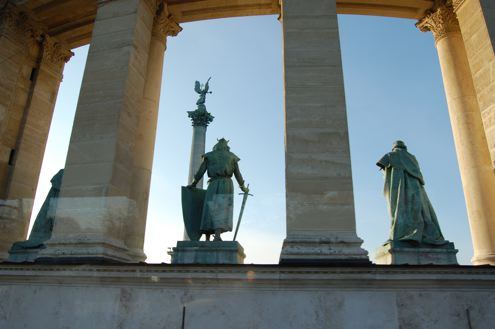 But that’s the nature of river cruises: you get a limited amount of time in each town, with the tradeoff that you get to come home to the same comfy room each night, and you develop fast friendships with other guests.
But that’s the nature of river cruises: you get a limited amount of time in each town, with the tradeoff that you get to come home to the same comfy room each night, and you develop fast friendships with other guests.
Over dinner at the captain’s table, I got my second wind as the wine, conversation and stories flowed from the numerous Australian, Canadian, South African, British and American guests. The staff of 43 onboard is also a mini United Nations, with most hailing from Bulgaria, Romania, Hungary, the Netherlands, Austria and Germany.
As I (and the River Beatrice’s 150 other guests) snoozed, we were barely aware that Captain Stefan Ivanov had begun silently steering the ship upriver on its 120-mile journey toward Bratislava.
Learn more about river cruising with Barging Through Europe.
Bratislava
One lock and 16 hours later, we arrived in Bratislava. There is something very seductive about falling asleep in one city and waking up in another—and not having to unpack, or even take a taxi to get to the city center.
In Bratislava, we docked literally adjacent to the old town area, which was a mere two-minute walk from the boat. Not that I wanted to walk as the temperature was steady at 28 degrees, but with the new day came snow and wind.
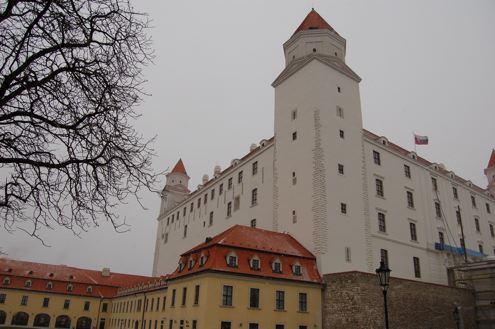 Seeing the town from the inside of a tour bus is not normally my preference, but considering the brutal weather and the dry wit of the Slovak tour guide, it turned out to be a very wise choice. Though not much was visible considering the storm, the tour was enough to give a flavor of the Slovak capital, which is as modest as Budapest is grand.
Seeing the town from the inside of a tour bus is not normally my preference, but considering the brutal weather and the dry wit of the Slovak tour guide, it turned out to be a very wise choice. Though not much was visible considering the storm, the tour was enough to give a flavor of the Slovak capital, which is as modest as Budapest is grand.
Though it actually served as the capital of the Hapsburg Hungarian kingdom for a couple hundred years (1536-1783), Bratislava—known as Pressburg for much of its history— does not make nearly as big a visual impact as the current Hungarian capital. (Maybe it does under the splendid summer sun, but in winter, not so much.) It offers the requisite cathedral, a castle on top of a hill, an old town section, and memorials overlooking the city, but on a smaller scale.
Spend Christmas in Europe: ‘Tis the Season for Escaping to Europe.
Despite its underwhelming appearance, Bratislava is marinated in history. At the crossroads of central Europe, it was almost conquered by the Turks, was the scene of 11 Hapsburg coronations, and was attacked by Napoleon’s armies in 1809. In fact, more than 100 cannon balls from the siege are still embedded in old town Bratislava’s ancient buildings to this day, though only a few are visible.
A bronze statue of the famous would-be invader also lurks in the old town area, but it’s not a commemorative type of monument. The Corsican leans casually on a park bench, forever peering over the shoulders of tourists who sit there.
If you’re in Bratislava, check out nearby Prague. Our Off the Brochure Travel Guide: Prague, Czech Republic, is here.
The old town contains a number of other whimsical statues, including Cumil, the sewer worker emerging from a manhole, a paparazzo lurking around the side of a building, and Schone Naci, an eccentric but elegant old man who frequented the streets of Bratislava for more than 40 years.
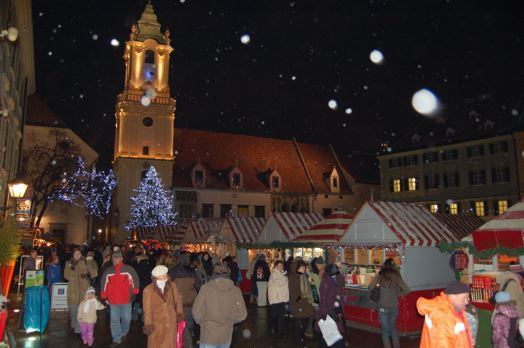 The Christmas market, which is also sited in the old town, was smaller than Budapest’s, but less commercial and more festive. Folk singers in native costumes sang carols on an adjacent stage as hundreds of Bratislavans chowed down on sausage, lokše (potato crepes), štrudla (strudel) and palacinky (crepes).
The Christmas market, which is also sited in the old town, was smaller than Budapest’s, but less commercial and more festive. Folk singers in native costumes sang carols on an adjacent stage as hundreds of Bratislavans chowed down on sausage, lokše (potato crepes), štrudla (strudel) and palacinky (crepes).
The Christmas market was only started in 1993, after Slovakia threw off the yoke of Communism and “divorced” itself from the Czech Republic. From what I’ve heard, Bratislava was not a fun place back in the heyday of communism. Dark, dismal and depressing, the town was grim and its residents pilloried in the media for being out of touch and unfashionable (think of the “two wild and crazy guys” from Saturday Night Live back in the late 1970s).
20 years later, Bratislava seems to have bounced back nicely enough to make it a perfect one-day stop on any central European itinerary, whether you get there by riverboat, plane or train. Just try not to visit on the coldest, snowiest day of the year—if you can help it.
After the Christmas market I headed back to the boat to compare purchases, eat a gourmet dinner, and hear the featured entertainment for the evening: the Pressburger Duo. Later, as I drifted off to sleep in my elegant and surprisingly spacious stateroom, the engines fired up and the River Beatrice continued its silent slide upriver.
Keep reading: Cruising the Danube River, Part 2: Vienna and Krems …
Text and photos by Karen Elowitt for PeterGreenberg.com.
Get more European Travel advice:












